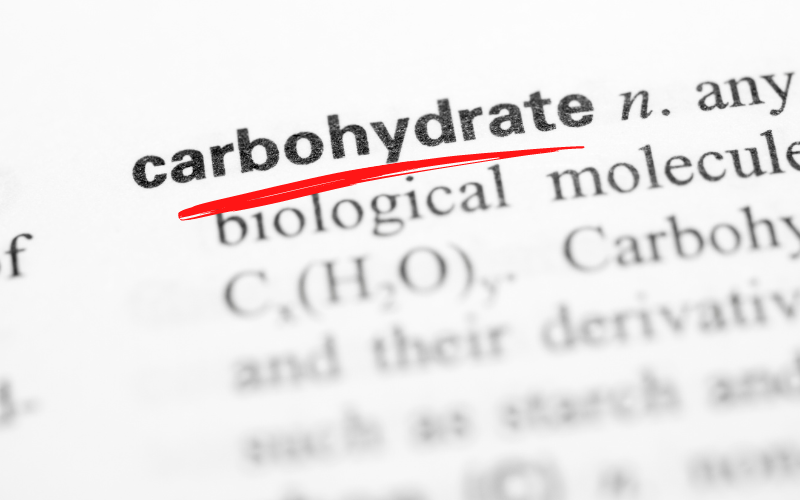If you’re in the natural product market, then you know what carbohydrates are.
But do you know exactly how carbohydrates are classified and their precise role?
In our latest article, we’ll look closely at carbohydrates’ characteristics and explore their relation to glycemic health.
So if you’re ready to learn more about these important nutrients, keep reading!
Did you know that there are two classifications for carbohydrates?
– The biochemical classification is based on the number of units.
- In this one, glucose is defined as a pyranose monosaccharide (i.e. a ring made up of 5 carbon and 1 oxygen atoms) with an aldehyde function.
- Starch is a polysaccharide formed of 2 compounds: amylose and amylopectin. Amylose is a linear glucose polymer, where glucose residues are linked together by α-1,4 bonds. Amylopectin is a branched glucose polymer that includes both linear links (α-1,4 bonds) but also side chains with α-1,6 bonds.
– The nutritional classification differentiates sugars according to their hyperglycemic power, i.e. according to their glycemic index and glycemic load.
- In this classification, glucose is defined as a simple sugar.
- Starch falls into the category of complex sugars.

Do you know the role of carbohydrates?
Nutritional needs include the three main macronutrients serving as an energy source or building blocks for our body. Carbohydrates represent the major part of our nutritional needs. Glucose, a carbohydrate, is the preferred substrate for cellular functions and is the main form under which carbohydrates are assimilated.
It is an essential source of energy for tissues and cells, such as our brain. 1g of glucose is equal to 4 kcal. It is, therefore, necessary to get enough carbohydrates through the diet to cover energy needs. In addition to its energy role, glucose has a structural role (for example in nucleic acids (DNA/RNA), coenzymes (NAD/NADP), glycoproteins, glycolipids and proteoglycans). It is also involved in the detoxification of the body.

Did you know that the intestinal mucosa is impermeable to carbohydrates?
The intestinal mucosa is impermeable to carbohydrates larger than the individual glucose units. As a result of the digestion of carbohydrates, only monosaccharides are formed.
Through the process of digestion, our body can utilize a wide range of carbohydrate sources, from complex polysaccharides to simpler, shorter maltodextrins and disaccharides.

Who should care about their blood glucose?
In 2021, the number of adults with diabetes (20-79 years old) worldwide was 537 million. The total number of people living with diabetes is expected to reach 643 million by 2030 and 783 million by 2045. These numbers are even more alarming in developing countries.
Nearly 1 in 2 adults live with undiagnosed diabetes; that is 240 million unknowing diabetics!
In America?
Across the Americas, approximately 96 million American adults, more than 1 in 3 have prediabetes, 38.0% of the U.S. adult population. Of those with prediabetes, more than 80% don’t know they have it.
In Canada?
30% live with diabetes or prediabetes; 10% live with diagnosed diabetes.
In Europe?
In Europe, 64 million people live with diabetes, including 3.3 million in France and 6 million in Germany, i.e. 7.3% of the European population. In Germany, it is estimated at 7.4%.
What is prediabetes?
Prediabetes is characterized by moderate hyperglycemia that does not reach the diagnostic threshold for diabetes but is associated with a significant increased risk of progression to type 2 diabetes.
According to the criteria proposed by the WHO, prediabetes is defined by:
- Fasting blood glucose: blood glucose between 1.10 g/l and 1.25 g/l, after an 8-hour period and checked twice
- And/or glucose intolerance: blood glucose between 1.4 g/l and 1.99 g/l; 2 hours after an oral glucose load of 75 g.
Unlike diabetes, which is a disease, pre-diabetes is an intermediate state where everything is still reversible because type 2 diabetes has not yet set in. Taking food supplements that act on glycemic health can prevent or delay the progression to diabetes.
The hypoglycemic role of brown algae
The trend toward healthy aging is pushing the demand for natural, safe and effective nutritional interventions that may support healthy blood glucose levels.
Brown seaweeds are a source of various compounds, including phlorotannins, fucoidan, polyphenols and polyunsaturated fatty acids (PUFAs). Phlorotannins show various biological activities, including inhibition of α-amylase and α-glucosidase, which are key enzymes in the control of post-meal blood glucose responses (Neto T.R., et al., 2018).

Would you like to know more about the benefits of brown algae?
Do not hesitate to contact us. We would be delighted to discuss brown algae’s hypoglycemic role!
